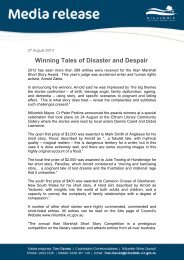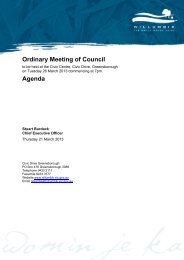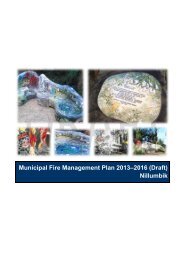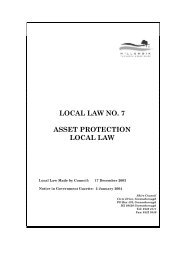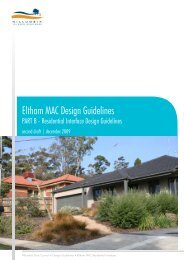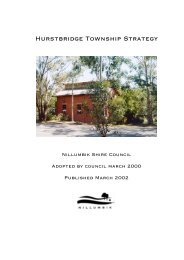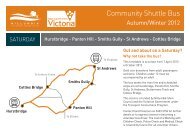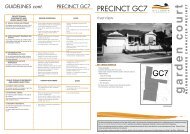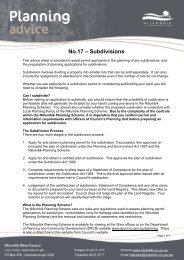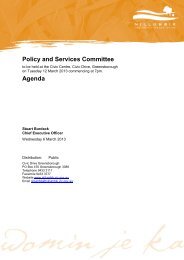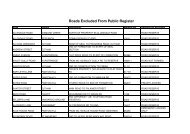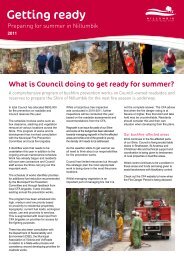Bulwidj (Box tree)
Bulwidj (Box tree)
Bulwidj (Box tree)
You also want an ePaper? Increase the reach of your titles
YUMPU automatically turns print PDFs into web optimized ePapers that Google loves.
Fauna<strong>Bulwidj</strong> Reserve is a part of a greater habitat area of high significance. It forms an important chain in the strategichabitat links north to Diamond Creek, east to St Andrews and south along Long Gully Creek to the Yarra River.Habitat resources in the reserve include:• areas of dense and open canopy• ephemeral watercourses and riparian vegetation species• open grassland with herb species (heath, peas and wattles)• steep gullies for fauna crossings• hollow bearing <strong>tree</strong>s• a significant stand of old growth <strong>tree</strong>s• Red Ironbark stands - Regent Honeyeater habitat• exposed rock/shale on hill - crests and slopes• dense, tall shrub layers including extensive stands of Burgan.A formal fauna survey of the reserve has not been undertaken specifically on this reserve but past studies (theNEROC Report) noted that <strong>Bulwidj</strong> contains the highest diversity of birds in the Kangaroo Ground to St Andrewsarea.Rare or threatened fauna species recorded in the area include the Regent Honeyeater, endangered in Australia,observed within <strong>Bulwidj</strong>’s Red Ironbark forest on two occasions some years ago; the Powerful Owl and theBrush-tailed Phascogale.This area also supports a significant assemblage of Honeyeaters and large populations of Eastern GreyKangaroo are present.
Additional significant species in the reserve identified through a study of vegetation in 2003 include:Botanical NameCarex incomitataDesmodium variansEryngium versiculosumGeranium pallidlorumHelichrysum sp. Aff. RutidolepisHydrocotyle tripartitaLevenhookia dubiaSpyridium parviflorumViola betonicifoliaCaledenia pusillaDoodia australisStylidium graminifolium s.s.Caledenia oenochilaCaledenia clavigeraAustrostipa rudis ssp. nervosaKunzea leptospermoidesPterostylis squamataLevenhookia sonderiCynoglossum suaeveolensNatadanthonia semiannularisLilaeopsis polyanthaHydrocotyle tripartitaCarex inyxDichelachne micranthaImperata cylindricaRanunculus glabrifoliusIsolepsis fluitansHypericum japonicumGoodenia elongataLilaeopsis polyanthaMeleleuca ericifoliaHypoxis vaginataCalochilus paludosusLindosa linearisBracyscome uliginosaSiloxerus multiflorusDiuris pardina x sulphureaAjuga australisBillardiera scandens var. brachyantheraOlearia myrsinoidesCorybas incurvusCaledenia praecoxCaesia parviflora
FaunaBunjil Reserve’s range of vegetation communities provides a variety of habitats for a range of animals. Thereserve is also part of a significant habitat linkage route, referred to in the NEROC Report as the Long Gully Link.This habitat route includes four other reserves of the Panton Hill Bushland System: Wimby, Yanggai, Wurran andYirrip. The NEROC report records more than 70 native fauna species across an area of the Long Gully Linkwhich Bunjil is a significant part.There are vegetative links with <strong>Box</strong> Stringybark Woodland and Creek line Herb-rich Woodland communities. Theconnection between the reserve and surrounding areas allows for seasonal movement and dispersal of fauna insearch of food and breeding opportunities.Habitat fragmentation in the Panton Hill area means that the habitat link between Wimby, Bunjil and Wurran isthe most functional link between Watsons Creek and Diamond Creek. It is also an integral component of theYarra River – Kinglake Ranges link (NEROC Report).Habitat types at Bunjil include:• exposed rock/shale occurring on hill - crests and slopes• numerous dead Acacia stands• large Lomandra stands along Long Gully Creek (north) - good habitat for scrub birds• hollow-bearing <strong>tree</strong>s including several old growth <strong>tree</strong>s throughout the reserve which provide a great variety ofhollows. Hollows provide breeding opportunities, protection from predators and shelter for many native mammals,birds and insects.Large numbers of resident and migratory insectivorous passerines take advantage of the abundant nesting andforaging associated with the extensive ground layer vegetation along Long Gully Creek. Several species ofbreeding parrots and several nocturnal ground and arboreal mammals including Brown Antechinus, Long-nosedBandicoot, Bush Rat, Sugar Glider and Brush-tailed Phascogale are other significant faunal assemblagessupported at Bunjil.A number of VROT listed species may be present in Bunjil including the endangered Barking Owl, the vulnerablePowerful Owl, Speckled Warbler, Brush-tailed Phascogale, Common Dunnart and the near threatened NankeenNight Heron.Bunjil is also doubtlessly an important reserve for numerous regionally rare species including White-throatedNightjar, Masked Woodswallow, Brown Antechinus, Long-nosed Bandicoot and Feathertail Glider.Heritage featuresA study in 2005, identified a previously unrecorded historic cultural heritage site, the Bunjil artefact, which is ascatter of mid 20th century domestic refuse, located in the northern section of the reserve. The datable itemsidentified within this rubbish dump suggest that it probably dates to the late 1940s or 1950s.Located in Chinaman’s Creek, 6m west of the track leading from the Rogers Road entrance to the reserve is anL-shaped section of dry-stone wall. It has been suggested that these walls may be associated with 19th centurymining activities within the reserve. However, the absence of associated evidence of gold mining, the proximity ofthe dam and the presence of a 20th century drainpipe within one of the wall sections, indicates that they aremorel likely associated with 20th century drainage/water channeling in the area.
Gawa (Echidna)Gawa Reserve is a linear creekline reserve of approximately five hectares and represents some high qualityManna Gum Riparian Forest, with large old <strong>tree</strong>s and dense tussocky ground habitat.The reserve's values are in its position along Watsons Creek forming part of an important habitat link alongWatsons Creek south to the Yarra River; north along the Long Gully Creek link to Diamond Creek; and northeastalong the roadside and private bushland of the Eltham-Yarra Glen Road. These stretches of bushland forma major habitat network between the Yarra River and the Kinglake Ranges. The NEROC Report argues that themaintenance of these habitat links in good condition, particularly Watsons Creek, is vital to the continuingpresence of mountain fauna in Warrandyte State Park and for the safe movement of koalas upstream.Geology and hydrologyGawa, in common with the other reserves, is on sedimentary derived soils, in this case recent Quaternary alluvialsands, silts, clays and gravels.The reserve contains two creeks, the Watsons Creek and an unnamed creek which runs into it. Watsons Creekhas minimum to no flow for three months over late summer to early autumn.VegetationA study in 2001 identified the following vegetation communities at Gawa Reserve:• Riparian Forest: Manna Gum (creek)• Valley Grassy Forest: Manna Gum (creek terrace)• Herb-rich Foothill Forest: -Red Stringybark (gully)• <strong>Box</strong>- Stringybark Woodland: Yellow <strong>Box</strong> (hill-slope)• <strong>Box</strong>- Stringybark Woodland: Long-leaf <strong>Box</strong> (sheltered hill-slope)These broadly correspond with the following Ecological Vegetation Classes:• Riparian Forest (EVC 18)• Valley Grassy Forest (EVC 47)• Herb-rich Foothill Forest (EVC 23)• Grassy Dry Forest (EVC 22)One hundred and ninety-eight indigenous species have been identified along Watsons Creek, however, thesection of Watsons Creek along which Gawa lies is less floristically rich than that along the stretch of creek northof the Eltham-Yarra Glen Road (NEROC Report).The structure and composition of vegetation in the reserve can be summarised as:• forest: tall eucalypt canopy, large old <strong>tree</strong>s, dense shrub layer, ferns, sedges, rushes grasses, shade tolerantherbs, riparian herbs• woodland: eucalypt overstorey <strong>tree</strong>s of varying ages, sparse shrub layer, wattles, herbs, daisies, orchids,grassland dominates understorey• hill-slope: upper slope eucalypt overstorey <strong>tree</strong>s of varying ages, shrub layer virtually absent, grazedunderstorey of introduced grasses and indigenous grasses/sedges. The shrub layer increases on the lowerslopes.• creek embankment and creek line: large grass, sedges, rushes tussocks, small shrubs, riparian herbs, climbers• open areas (vegetation clearance): western section. Modified landscape due to grazing comprising a mixture ofintroduced grasses and indigenous grasses/sedges.Vegetation condition is variable. The central section contains most of the relatively intact bushland and qualityand health declines where disturbance has occurred. Along the creek itself there is good quality vegetation,particularly an extensive and intact stand of Lomandra longifolia. This extends on both sides of the creek.Surveys so far have not revealed any species listed as VROT at Gawa Reserve, seven significant species formanagement have been identified. These include:
FaunaGawa forms part of an important riparian habitat link from Watsons Creek south to Yarra River and north alongthe Long Gully Creek link to Diamond Creek and north-east along the roadside and private bushland of Eltham-Yarra Glen Road (designated Site 63b in the 1997 NEROC Report). These links are part of a critical habitatnetwork being the only continuous riparian habitat link between the Kinglake Ranges and the Yarra River. Thesurrounding vegetation should be considered as part of the conservation values of the site, essential tomaintaining overall habitat values.There are numerous wombat burrows (the soil on the creek banks is suitable for burrows) along the entire lengthof the reserve and rabbits have utilised many of these. The food source for wombats is plentiful, the creek banksare vegetated with grass tussocks and tufted Lomandra and Carex.There is fragmented vegetation cover within open modified areas where the ground layer is a mixture of nativeand introduced grasses, a few sedges and herbs and an upper canopy of scattered Eucalypt stands (along thewestern boundary).This section of the creek supports a number of regionally significant fauna species including a number of birdspecies, the koala, the long-nosed bandicoot, platypus and river blackfish.Botanical nameAustrostipa rudis ssp nervosaDoodia australisDoodia caudateImperata cylindricalNotodanthonia semiannularisPomaderris racemosaTriglochin procerusCommon NameVeined Spear GrassRasp FernSmall Rasp FernBlady GrassWetland Wallaby-grassSlender PomaderrisWater ribbons
Wimby (Swamp Wallaby)Wimby is one of the smaller reserves (approx 12 hectares) within the Panton Hill Bushland Reserve Systemlocated mid-catchment. It is located between Long Gully and Howards Roads, Panton Hill. (Melway 264 D8).The northern section of the reserve begins at the junction of Howards and Blue House Roads. Long Gully Creekand the extension of Blue House Road (emergency track) define the eastern boundary. The western boundaryadjoins private property. The southern boundary travels along Long Gully Road.Wimby Reserve derives its value from its position as part of the Long Gully Link faunal corridor (an importantmanagement unit within the Panton Hill Bushland Reserve System), its range of different habitat niches and itsareas of relatively intact vegetation. It also has significant cultural heritage values which require protection.Geology and hydrologyThe underlying geology of Wimby Reserve consists of:• newer Quaternary alluvium. Flood plains of depositional clay, coarse and fine-grained sands and organic silts.Lower and middle reaches (from downstream section of Wimby) of Long Gully Creek• strongly dissected valleys• soils largely alluvial in origin• yellow duplex soil (deep grey loam topsoil) occupies terraces, valleys and foot slopes• soils in gullies are yellow loamy gradational – dispersible and erosion prone.A significant natural feature of Wimby reserve is Long Gully Creek, which runs the entire length of the easternboundary. Long Gully Creek is an ephemeral tributary of Watsons Creek that flows six to nine months of the year.The creek runs in winter and dries out in summer when it consists of shallow pools, exposed rocky reefs and drycobble and gravel riffles with sandy banks.Gullies and drainage lines transecting the reserve influence vegetation composition and structure. The gulliesvary in degrees of steepness and vegetation quality. The most significant is New Chum Gully running east-westthrough the southern part of the reserve. There is a large dam at the headwaters of New Chum Gully.Several narrow drainage lines travel downhill from private properties on the eastern boundary. These drainagelines intersect with the main recreational track before linking up with Long Gully Creek.VegetationWimby Reserve contains four Ecological Vegetation Classes:• Creek-line Herb-rich Woodland (EVC 164)• <strong>Box</strong> Stringybark Woodland (sub-set of EVC 22)• Valley Grassy Forest (EVC 47)• Grassy Dry Forest (EVC 22)Vegetation communities of regional botanical significance in the reserve include:• Creek line Herb-rich Woodland, stand relatively intact• Valley Grassy Forest, relatively intact stand; supports the highest diversity of Victorian rare or threatenedspecies in Wimby• <strong>Box</strong> Stringybark Woodland, relatively intact.Wimby Reserve has only moderate degree of flora richness and diversity. However some species occurinfrequently. Of the 330 species of indigenous plants within the reserve system recorded in a study in 2001, 197were found to occur within Wimby Reserve. Further indigenous species were recorded in a study in 2003.Much of the vegetation on the reserve is relatively intact and has been rated as low State Botanical significancewith areas of Regional Botanical significance.Long Gully Creek varies in vegetation quality. The best areas are located in the north-eastern section of thereserve where good quality Valley Grassy Forest occurs on both sides of the creek and supports the reserve’shighest diversity of Victorian rare or threatened species.FaunaWimby is a dynamic reserve with concentrated topography. The resulting vegetation structural diversity providesa good range of habitat types and niches, supporting a diverse range of animals.Within the Panton Hill Bushland Reserve System, Wimby is centrally located and is part of the important faunal
corridor, named in the NEROC Report as The Long Gully Link. This habitat route includes four other reserves ofthe Panton Hill Bushland System: Bunjil, Yanggai, Wurran and Yirrip. There are also vegetative links with <strong>Box</strong>Stringybark Woodland and Creek line Herb-rich Woodland communities.The connectivity of the reserve to surrounding areas allows for the seasonal movement of fauna in search of foodand breeding opportunities. There are several local public reserve connections:• Yanggai and Yanggai East reserves to the north linking to <strong>Bulwidj</strong> and Boomers Reserve (managed by ParksVictoria)• Motshcall Reserve to the south linking to Bunjil Reserve• Vegetation links to remnant roadside reserves along Howards, Long Gully and Blue House Roads.Habitat features observed within Wimby Reserve include:• Forest: tall <strong>tree</strong> canopy, lower slope shrub layer and shade tolerant species, upper slopes support hillcrestspecies. Hollow-bearing <strong>tree</strong>s provide breeding opportunities, protection from predators and shelter for nativemammals, birds and insects• Woodland: eucalypt overstorey <strong>tree</strong>s of varying ages, shrub layer, grassland dominates understorey; shadetolerant herbs• Hill-slope/creek valleys: open <strong>tree</strong> canopy, medium-low shrub layer, herbs and grasses; exposed rock/shaleoccurring on hill-crests and slopes• Creek line: aquatic species, rushes, sedges, herbs and climbers. In-stream habitat allowing faunal movementand providing breeding areas. Rock pools support aquatic species interspersed with rock bars and mud bankssupporting semi-aquatic grasses and sedges.• Drainage lines: riparian species and higher frequency of climbers• northern dam (very small in size): sedges, grasses, wattles and a few eucalypts - modified landscape• open areas (vegetation cleared): northern west section corner of the reserve. Modified landscape that has beengrazed; a mixture of introduced grasses and indigenous grasses/sedges; shrub and <strong>tree</strong> canopy absent• hollow-bearing <strong>tree</strong>s - there are a few old growth <strong>tree</strong>s throughout the reserve providing a variety of hollows.There is a notable absence of hollow-bearing <strong>tree</strong>s along New Chum Gully and upper slopes.• Some weed species function as habitat along New Chum Gully. Blackberry supports small birds, however thereis adequate native shrub layer habitat within the area.There is a high percentage of plant litter, coarse woody debris and fallen timber throughout the reserve. Areasprone to more frequent disturbance events have higher concentrations of fallen timber than others i.e. New ChumGully and Long Gully Creek within the southern area where fallen timber has accumulated due to flooding.The fauna communities and descriptions at Wimby are consistent with those found at Bunjil Reserve.There are faunal species of state, regional and local significance present within Wimby reserve. The NEROCReport (sites 78a Long Gully Link) provides a useful reference to the faunal values of the site. It records morethan 70 native species across an area of which Wimby is a significant part.The same VROTS that may be present in Bunjil may be present at Wimby – the endangered Barking Owl, thevulnerable Powerful Owl, Speckled Warbler, Common Dunnart, Brush-tailed Phascogale and the near threatenedNankeen Night Heron included.Wimby too, is an important reserve for numerous regionally rare species including White-throated Nightjar,Masked Woodswallow, Brown Antechinus, Long-nosed Bandicoot and Feathertail Glider.Significant fauna previously recorded at Wimby Reserve include:• Barking Owl: endangered in Victoria - located by Long Gully Creek at Howards Road• Long nosed Bandicoots (Perameles nasuta): regionally vulnerable - located in north-eastern section of reserve.Heritage featuresThe Victorian Heritage Inventory includes a listing for the Long Gully Settlement and Mining ruins located withinWimby Reserve. The site was potentially a result of the activities of Chinese miners including a garden andresidence. A diversion channel and traces of alluvial gold mining were recorded in the creek (New Chum Gully)immediately below the block.The site contains remains of the Freeman Homestead identified by a stone and mud wall section which can beaccessed from Long Gully Road formal entrance. The remains of the Freeman Homestead are reasonablystable, although the stone and mud brick wall is slowly degrading over time.
Wurran (Sugar Glider)Wurran is the smallest (approx seven hectares) of the Panton Hill Bushland Reserve System (PHBRS) reservesand, like Gawa, is a narrow creek line reserve. It is immediately south of and adjoining Long Gully Reservewhich in turn joins Bunjil Reserve.The southern edge of the reserve is at the bridge on Long Gully Road. The eastern boundary is defined by LongGully Creek and the western boundary adjoins private property. It lies parallel to Long Gully Road, with a steepslope to Long Gully Creek. Wurran is part of the upper catchment of the PHBRS.The primary significance of Wurran Reserve lies with its habitat values, providing good habitat for wombats,birds, and sugar gliders.Its geographic position on Long Gully Creek also means that it has significance as a strategic habitat link, beingpart of the Long Gully Habitat Link.Geology and hydrologyAs with the other reserves, soils are sedimentary. Much of Wurran lies on recent Quaternary alluvial sands, silts,clays and gravels.Long Gully Creek flows north-south through the reserve, running for six to nine months of the year. The creekbed contains rocky reefs but gold mining has changed creek bed levels. Gullies and drainage lines running intothe reserve from private properties are stable at this stage because of vegetation cover.VegetationEcological Vegetation Classes (EVCs) identified on the site are:• Creekline Herb-rich Woodland (EVC 164)• Valley Heathy Forest (EVC 127)• Grassy Dry Forest (EVC 22): <strong>Box</strong> Stringybark Woodland variant.And the following sub-communities:• <strong>Box</strong> Stringybark Woodland: Yellow <strong>Box</strong> (hill-slope), Long Gully Rd• <strong>Box</strong> Stringybark Woodland: Long-leaf <strong>Box</strong> (sheltered hill-slope)• Creekline Herb-rich Woodland: Manna Gum- Swamp-Gum (foothill creek)• Valley Heathy Forest: Red <strong>Box</strong> – Narrow – leaf Peppermint (foot-slope)The following are sites within Wurran Reserve have been identified as being of Regional Botanical Significance :• Long Gully Road: a stand of the endangered hill-slope sub-community of <strong>Box</strong>-Stringybark Woodland, somewhatdegraded but the main occurrence in PHBRS. It is one of few in the regional biological reserve system.• High side of Long Gully Road: an area of grassland of high regional significance supporting Desmodium varians(Slender Tick-trefoil) and Geranium pallidiflorum var. roseum (Rosy Crane’s-bill). No relatively intact stands arepresent in the block.Over 200 indigenous species have been identified in the reserve. Topography and aspect influence percentageand transition of species and structural diversity. Wurran contains:• Open Woodland canopy• Tall-low shrub layer• Tall forest canopy• Ephemeral watercourse• High diversity of riparian species• Dense sedge/rush/tussock layer• Grassland, herbs and shrub land (heath, peas, wattles)Vegetation condition is variable, and where disturbance has occurred, quality and health declines. There areearly signs of dieback occurring along the creek line, the majority of which can be found in southern section.Overall vegetation quality increases on the eastern boundary hill-slopes. The ground layer on the eastern side ofthe creek in the southern section appears to have been mown/slashed and the shrub layer is virtually absent onthe higher slopes adjacent to Long Gully Road.The northwestern section is the widest point of the reserve and contains a weed ‘hot spot’ amongst a stand ofEucalypts. The southern section of the reserve was heavily mined, and is of low quality, with major weedinvasion.Mature and hollow-bearing <strong>tree</strong>s are generally lacking within the reserve although indigenous species areregenerating.
FaunaWurran Reserve is a part of a greater habitat significance area and strategic district habitat link. It is an essentialcomponent of the Long Gully Link mentioned on the Bunjil Reserve page on the website.All strata of habitat are present within the reserve but specific habitat features include:• Large Lomandra and tussock stands along Long Gully Creek, which provide good habitat for scrub birds andconstitute a food source for wombats.• The gum from Black Wattles provides an important autumn/winter food for sugar gliders.• Organic matter and flood debris in the creek bed.Perhaps the most obvious deficiency is a paucity of hollow-bearing <strong>tree</strong>s.The habitat is damaged by rabbits, which have had a substantial impact on the creek embankments through thereduction of vegetation cover by grazing and digging warrens.The state vulnerable Brush-tailed Phascogale has been recorded on private bushland 300 metres east of reserveand are likely to exist on reserve. There are numerous wombat burrows in the creek banks along the entirelength of the reserve and rabbits also use them. Kangaroos and wallabies cross the creek, mainly in the northernsection of the reserve.Heritage featuresA historic alluvial gold mining site in Wurran Reserve was identified in 2005. The extensive site extends alongmuch of the eastern side and the southern portion of the western side of Long Gully. It comprises shallow miningpits, mullock heaps and some channels associated with alluvial gold mining. A single diagnostic piece of lightgreen glass from a bottle manufactured in the mid to late 19th century was identified in this area.The western side of the reserve appears to have been more disturbed by recent activities than the eastern sideand there are a lot of introduced weed species present such as blackberries, bracken and thistles. Some miningpits were identified on the western side of Long Gully, 260 metres north of the southern end of the reserve andthese extend into the private property abutting the western side of the reserve.
Yanggai (Yellow-tailed black cockatoo)Yanggai Reserve is adjacent to the south-east corner of the nationally significant Boomers Reserve (managedby Parks Victoria) and provides an important extension of this habitat. A further botanical survey is required forYanggai and Yanggai East to determine the full extent of botanical values. In the meanwhile there is no doubtthat the reserves have high value as a wildlife corridor.Yanggai is in the upper catchment of the Panton Hill Bushland Reserve System. It has connections to otherpublic reserves. Vegetation links to remnant roadside reserves occur along Howards and Blue House Roads.Boomers Reserve is to the north of Yanggai and Wimbi Reserve is to the south.The main entrance to Yanggai is in Howards Road, Panton Hill. The northern boundary adjoins Parks VictoriamanagedBoomers Reserve; the remaining boundaries adjoin Blue House Road, Howards Road, and privateproperty.Yanggai East has an entrance off the disused section of Blue House Road.Geology and hydrologyThe underlying rock of Yanggai, as with the other reserves in the PHBRS, is sedimentary and was laid downduring the Silurian period. Soils on hillcrests and slopes are derived from this rock. Over much of YanggaiReserve there is a cover of more recent – Quaternary – alluvial soil. The landforms of the two reserves arefoothill: hillcrests, sheltered hill-slopes, drainage lines and damp gullies.Hydrological forms in and around Yanggai include:• a dam on north eastern boundary• Boomers Gully running from the north-western boundary to the southern boundary and joining Long GullyCreek.Hydrological forms in Yanggai East include:• an ephemeral tributary of Long Gully Creek running the entire length of the reserve, intersecting Blue HouseRoad and running along the eastern edge of Yanggai Reserve.VegetationEcological Vegetation Classes on these reserves are:• Grassy Dry Forest (EVC 22)• Valley Grassy Forest (EVC 47)And Sub-communities:Grassy Dry Forest: Red Stringybark, (sheltered hill-slope)Grassy Dry Forest: Red <strong>Box</strong> (exposed hill-slope)Valley Grassy Forest: Swamp Gum (drainage line) (Beardsell 2001)The diversity of flora species present at the reserve is inadequately known and further surveys are needed.Previous studies have identified that the two reserves combined contain around 200 indigenous species. Thebest quality vegetation is in the north- eastern section, however, previous clearing has reduced the numbers ofmature <strong>tree</strong>s, and understorey vegetation is fragmented and varies in quality. Over much of the reserve, weedinvasion and the development of extensive stands of Burgan compromise the quality of vegetation. Gullies anddrainage lines are also of poor quality.Yanggai East contains medium quality vegetation, but more intensive assessment is required to confirm this.
FaunaYanggai and Yanggai East are part of a greater habitat area of high significance, being part of a strategic districthabitat link and regional network link at Long Gully Rd (The Long Gully Link). Yanggai East links bushlandvegetation with Yanggai, Boomers, <strong>Bulwidj</strong> and Wimbi Reserves.Vegetation links to remnant roadside reserves occur along Howards and Blue House Roads. Boomers Reserveis to the north of Yanggai and Wimbi Reserve is to the south. There is a narrow strip of Crown Land north ofYanggai East, which runs along a gully linking <strong>Bulwidj</strong>.A summary of structural diversity characteristics of Yanggai and Yanggai East is:• Open Woodland canopy• Tall <strong>tree</strong> canopy• Ephemeral watercourses• Riparian species• Open grassland and herbs (Kangaroo Grass)• Grassland, herb and shrub land (heath, peas, wattles)• Dense tall shrub layer• Native fauna using gullies as crossings, bare soil potentially vulnerable to further disturbance if the public usestracks.• Exposed rock/shale occurs on hill - crests and slopes.• Extensive stands of BurganThere is high percentage of plant litter, coarse woody debris and fallen timber. Some areas have higherconcentrations of fallen timber due to recent Pine removal. Extensive fallen timber can make areas difficult toaccess and have weed control and fuel hazard implications.The Barking Owl, endangered in Victoria, is a resident of these reserves and was heard in 2005 within or nearto Yanggai East.Heritage featuresAn area of past gold mining exists within Yanggai. The Yanggai Gold Mining Area covers the entirety of thenortheastern section of the reserve along both sides of Long Gully and is characterised by shallow mining pitsand more extensively shallow open-mined areas, mullock heaps and channels.The area has been extensively mined and many of the pits are well preserved and have distinct sides andmullock heaps. All the pits are located within 50 metres of the creek, with some being quite open and large,while others are smaller and deeper. Despite the abundant evidence of alluvial gold mining activities, noindications of habitations were located. However, several diagnostic fragments of glass, indicating a mid to late19th century date of manufacture, have been identified.
Yirrip (Red Ironbark)Yirrip is approximately 22 hectares in size and is located in Panton Hill (Melway 272 H3). Couties Road, KoosRoad and Kings Road form three boundaries with formal entrances from Couties and Koos Roads.Yirrip is located to the south-west of the other reserves in the lower catchment of the Panton Hill BushlandReserve System (PHBRS). Of the reserves within the PHBRS, Yirrip is the most physically isolated from theother reserves. The northern hill crest provides a panoramic view in almost all directions – the best view withinthe PHBRS.Yirrip Reserve contains a range of vegetation, including three communities of Regional Botanical Significance.The reserve also has significant habitat value as a regional network link and is home to one endangered faunaspecies, the Speckled Warbler.Geology and hydrologyAs with all reserves in the system, Yirrip soils are sedimentary in origin. The underlying rocks are Siluriansiltstones and sandstones. The soils are shallow, stony, dispersible and erodible.A significant natural feature of Yirrip is an ephemeral creek, which runs the entire length of the eastern boundary.This becomes a tributary of Watson’s Creek.VegetationYirrip contains four Ecological Vegetation Classes (EVCs):• <strong>Box</strong> Stringybark Woodland (Grassy Dry Forest EVC 22)• Valley Grassy Forest (EVC 47)• Valley Heathy Forest (EVC 127)• <strong>Box</strong>-Ironbark Forest (EVC 61)The following vegetation communities in the reserve have been identified as being of Regional BotanicalSignificance:• <strong>Box</strong>-Stringybark Woodland (hill-slope): extensive stand, relatively intact• <strong>Box</strong> Stringybark Woodland: extensive stand, relatively intact• <strong>Box</strong>-Stringybark Woodland: (rocky hill- crest), small, partially intact, endangered.• <strong>Box</strong>–Ironbark Forest: Red Ironbark/Red <strong>Box</strong> (ridge), relatively intact regionally vulnerable.• Valley Grassy Forest: Swamp Gum (drainage line) Regionally endangered.Vegetation in the reserve is noted for its diversity and richness with 219 indigenous species being identified in astudy in 2001. Because of this and the quality of vegetation, it has been identified as being of High RegionalBotanical significance.FaunaYirrip is part of a significant habitat linkage route to the east, which joins a regional network link at Long GullyRoad referred to as the Long Gully Link.Vegetation links to remnant roadside reserves occur along Couties, Kings and Koos Roads, and private propertybushland links occur on all boundaries.Yirrip is a dynamic reserve with concentrated topography. The resulting diversity of vegetation structure providesa variety of habitats. These include:• Valley Grassy Forest: Swamp gum (drainage line)• Open <strong>tree</strong> and tall shrub strata• ground stratum dominated by tussocks - found on fertile sites along upper sections of creeks• Woodland: eucalypts of varying ages, shrub layer, orchids, grasses - Hill-slopes/creek valleys• a small stand of Red Ironbark on the hillcrest: its shrub layer virtually absent, a heavily grazed understorey• In-stream habitat and also diverse vegetation along the creek line allowing faunal movement and providingbreeding areas• Escarpment habitats: <strong>tree</strong>s with a dense tall shrub layer, and a diverse grassy understorey.Old growth <strong>tree</strong>s are scattered throughout the reserve and provide a variety of hollows for a range of nativemammals, birds and insects. There is a notable absence of hollow-bearing <strong>tree</strong>s in the northern and southernsections. Dieback in the central southern section of the reserve presents a major threat to habitat values and the
health of medium to large old <strong>tree</strong>s.A high percentage of plant litter, coarse woody debris and fallen timber covers the ground in the central sectionand central southern/eastern section of the reserve.In open modified areas, particularly in the northern section and southwestern corner, weeds such as Blackberryprovide habitat for scrub birds where native shrubs are absent.Species recorded in the reserve include the Speckled Warbler which is vulnerable in Victoria. This species wasrecorded in Hedge Wattles on the north hill slopes.Heritage featuresThe historic heritage values of Yirrip were assessed in 2005 and no historic cultural heritage sites were found onthis site. Mature fruit <strong>tree</strong>s provide evidence of a previous orchard in the northern section of the reserve.



